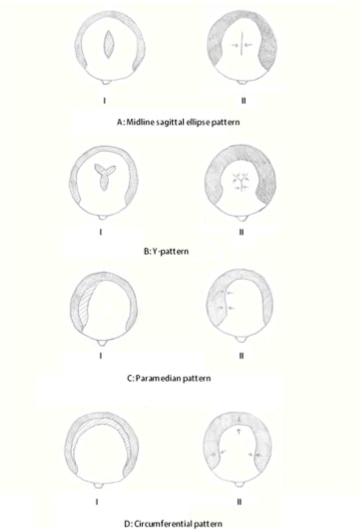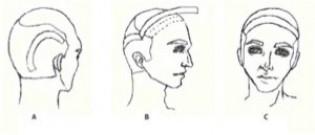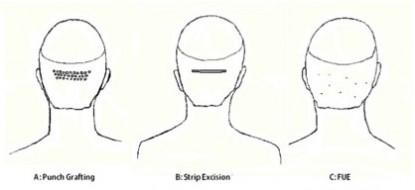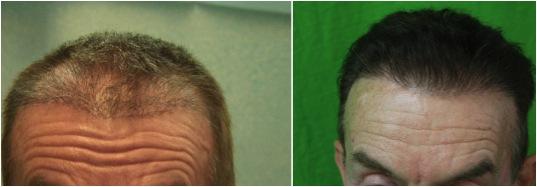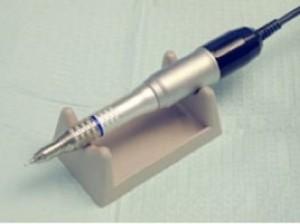FUE stands for follicular unit extraction. Hair restoration refers to any medical or surgical process that reverses hair loss. This might include topical and oral medications such as minoxidil and finasteride, or a procedure like punch grafting. In Los Angeles, FUE hair restoration is the premier surgical method of getting one’s hair back. However, other procedures, some antiquated and some modern, include:
- -Scalp reduction
- -Temporo-occipital flap surgery
- -Punch grafting
- -Hair transplantation
The first two on the list are nearly obsolete in the way of restoring hair. Both are highly invasive and infamous for risking permanent nerve damage, severe scarring, and other complications. Punch grafting is known for creating a pluggy “doll’s hair” look, and also for leaving large round scars. This makes hair transplantation today’s surgical procedure of choice.
FUE HAIR RESTORATION—WHAT IS IT?
FUE was invented in the 1980’s but largely developed in the 1990’s. It harvests individual donor grafts from anywhere on the scalp (or body, with advanced FUE body hair transplant). These tiny grafts—called follicular units—are excised one by one with a 0.8 to 1.2mm punching tool and needle device. They are then implanted into the recipient area with care and precision. This minimally invasive microsurgical procedure involves no scalpel, and thus leaves patients without the need for stitches or staples. It also means:
- -Healing time is quicker
- -Scarring is minimized
- -Hairline design and global density are enhanced through specified donor hair selection
FUE HAIR RESTORATION VS. STRIP HARVESTING
The two types of hair transplant that have risen to the forefront of today’s technology are follicular unit extraction and strip harvesting. Developed in the 1980’s, strip harvesting—technically called follicular unit transplant (FUT) and also known as strip surgery—has a very different excision process. This technique, being the first invented of the two, would be considered the less sophisticated, however it is still widely used.
In Los Angeles, FUE hair restoration aligns more with the culture of high-caliber beauty and cosmetics due to its superior aesthetic result. Strip harvesting excises an entire strip of flesh from the mid-rear scalp, to later be dissected into follicular units for implantation to the recipient area. It requires stitches or staples to close the wound, and thus results in a large linear scar at the back of the head (which is likely to stretch over time). In addition, FUT derives the hair from the thickest-growing part of the scalp, which limits the artistic creation of a natural-looking hairline.
FUE HAIR RESTORATION—TERMINOLOGIES AND PRACTITIONERS
As with most medical services, treatments, and cosmetics available, every method branches off into competing brands. Follicular unit extraction has various monikers, including:
- -FOX technique
- -Woods technique
- -SAFE
- -CIT
- -FUSE
- -uGraft
And the list could go on. These names are each a brand of FUE that has been developed by independent pioneering physicians. They each differ slightly in procedure and tools used. Last on the list is a true Los Angeles FUE hair restoration brand; developed by Dr. Umar of FineTouch Dermatology and DermHair Clinic, the uGraft or “The Umar Procedure” is an advanced technology. uGraft enables the excision of donor hair from the head with enhanced precision, minimized transection, and minimized graft burial; which also bestows the groundbreaking ability to safely excise donor hair from the body. This revolutionary technique is the salvation that all severely bald patients have been looking for. Dr. Umar is certified by the American Board of Dermatology and is the world-leading practitioner of large-volume body hair transplant.
FUE HAIR RESTORATION METHODOLOGY
During the procedure, the following steps will ensue:
- Surgeon incises the skin surrounding the follicular unit using a punch-like device with a rotary motion. (Historically, these punches had a 4mm diameter which left massive scarring. Today, punches are no larger than 1.2mm.) Depth of incision varies and depends on tissue attachment to the follicle.
- Surgeon removes donor follicle from scalp.
- Donor follicles are placed in a preserving solution.
- Customary blades make microscopic slits in recipient area.
- Donor follicles are implanted into slits.
FUE HAIR RESTORATION PITFALLS
While FUE hair restoration is the premier hair transplant technique, it does have its disadvantages. One of the major drawbacks is that it tends to be more costly, for the following reasons:
- -Each FUE extraction is considered a surgical procedure, thus the surgeon himself, or an equally certified physician, must perform each and every extraction.
- -The procedure is lengthy due to the potentially thousands of extractions performed.
- -The tedium and labor-intensive nature requires an exceptionally skilled practitioner to perform FUE successfully. A novice practitioner may produce subpar results (this is also true of strip harvesting).
Additionally, though some of the best surgeons in the world practice in Los Angeles, FUE hair restoration cannot treat everyone. As with all surgical procedures, there are poor candidates. People prone to keloiding, scar hypertophy or other such abnormal scarring tendencies are poor candidates for hair transplant; as well as people with blood clotting abnormalities and allergies to local anesthesia.
FUE HAIR RESTORATION TOOLS:
Among the arsenal of tools used for Los Angeles FUE hair restoration and elsewhere, there exists manual tools, powered tools, automated machines, and robotic devices.
Manual Tools: The first FUE punching tool, resembling a pen, was simple, manual and handheld. It required the surgeon to rotate the tool by hand in order to excise the follicle from the flesh.
Powered Tools: The next step was a handheld device with an electromechanical rotary punch. This refines the excision process and lowers transection rates by requiring less movement from the practitioner. Some powered tools incorporate depth control. Los Angeles FUE hair restoration methods like uGraft use a similar tool.
Automated Devices: NeoGraft has become a popular FUE extraction tool. It uses an electromechanical punch with air-vacuum technology to suck the graft away from the scalp as it is being excised. Designed to expedite the tedious excision process, NeoGraft inherently desiccates the graft, compromising graft survival. This might undermine the overall success of the transplant.
Robotics: Extraction is entirely machine-run with robotic devices like Artas. This machine uses 3-D imaging software, cameras, and color identification sensors to perform FUE like a human practitioner, without the human. Artas only works on people with straight hair that is black or brown in color. Tests have cited high damage rates with this tool, including high incidence of buried grafts and excessive transection rates.
FUE HAIR RESTORATION—CHOOSING THE RIGHT SURGEON
Selecting the right surgeon will make or break your hair transplant results. Follow these steps to ensure you choose the best surgeon for you:
- -Choose a surgeon with the proper licenses and certifications.
- -A practitioner with plentiful and diverse EXPERIENCE is paramount.
- -Demand to see video and photo results of the surgeon’s prior patients.
- -Be sure he/she is vouched for by the Los Angeles FUE hair restoration community, the broader hair transplant community, and his/her prior patients.
- -Be aware of who will be performing your procedure, the specific role of each medical technician present, and the qualifications of every individual.
- -Be sure to ask if the extraction process uses handheld or robotic tools and if vacuum technology is used.
- -Get a personalized consultation before committing to any one doctor.

